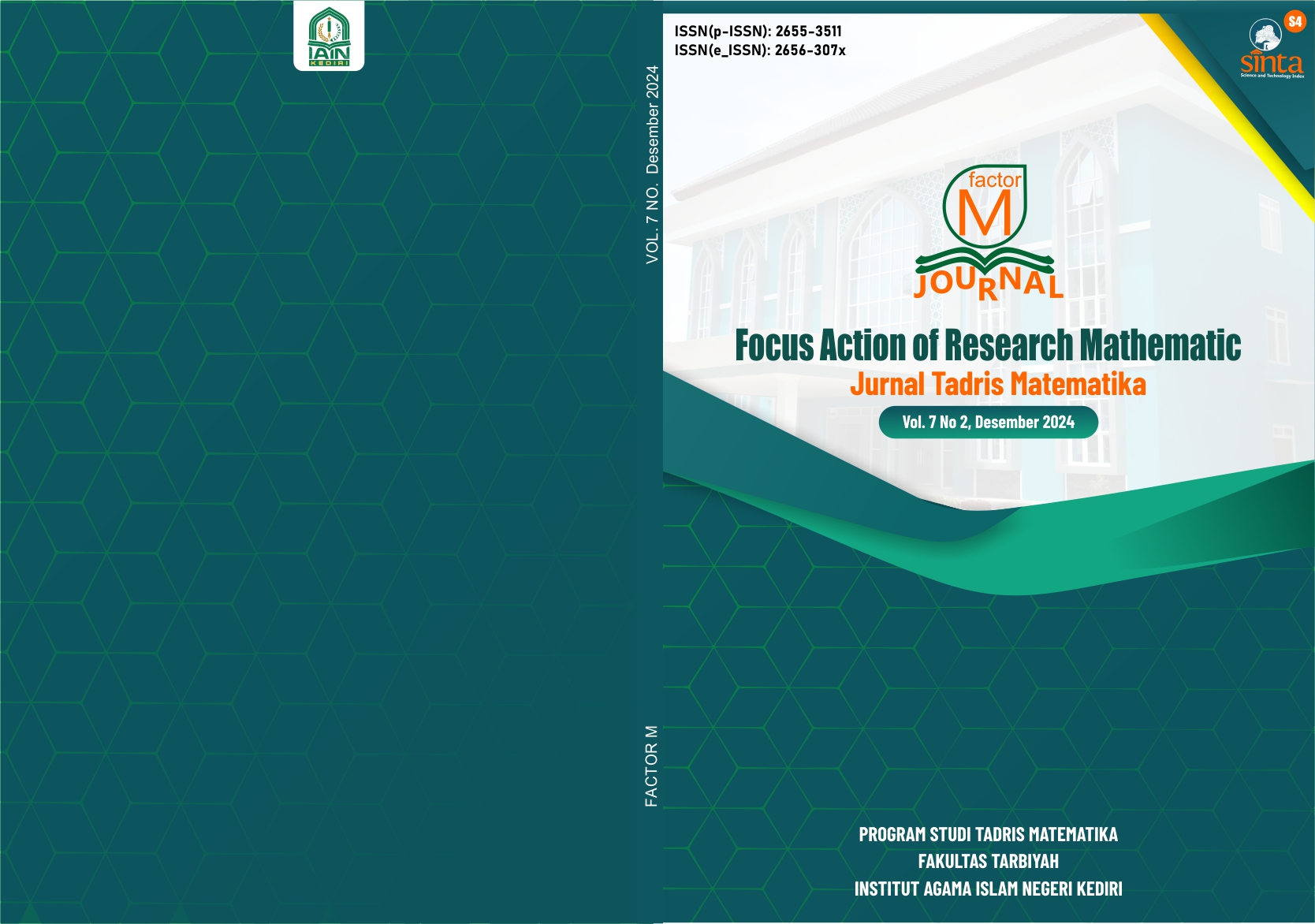Dynamical analysis of a mathematical model on the spread of diphtheria disease with vaccination completeness factors
DOI:
https://doi.org/10.30762/f_m.v7i2.3901Keywords:
Diphtheria, Dynamical Analysis, Mathematical Model, Vaccination CompletenessAbstract
The COVID-19 pandemic has impacted many aspects of life, including immunization services. As a result of disruptions in these services, tens of millions of children worldwide are at risk of contracting diphtheria, hundreds of thousands of infants did not receive complete DPT immunization, and more than a million infants missed BCG vaccination at birth. Over the past three years, there has been an increase in mortality rates, reaching 10.6% in 2022. Additionally, the number of diphtheria cases in 2022 was more than twice that of 2021. To address the re-emerging of diphtheria, various studies have been conducted, one of which is through mathematical modeling, which can be useful in predicting the dynamics of disease spread and devising strategies to control it. This study developed a mathematical model to describe the dynamics of diphtheria spread with the influence of vaccination completeness. The dynamical analysis method used is by analyzing the eigenvalues and numerical calculation, while numerical simulations employ Fourth Order Runge-Kutta Method. Results from the dynamical analysis and numerical simulations indicate that the disease-free equilibrium point is stable if basic reproduction number , and the endemic equilibrium point is feasible and stable if . Moreover, increasing the vaccination completeness factor within a given population can aid in efforts to prevent the spread of diphtheria. Based on the simulation of the scenarios developed in this study, diphtheria will not become endemic when the vaccination completeness factor reaches 90% and the treatment rate reaches 30%.
Downloads
References
Ahmed, I., Kiataramkul , C., Muhammad, M., & Tariboon, J. (2024). Existence and Sensitivity Analysis of a Caputo Fractional-Order Diphtheria Epidemic Model. Mathematics, 12(13), 2033. doi:https://doi.org/10.3390/math12132033
Aryania, I., & Widyaningsih, P. (2020). Model Susceptible Vaccinated Infected Recovered (SVIR) dan Penerapannya pada Penyakit Difteri di Indonesia. PRISMA, Prosiding Seminar Nasional Matematika, 3, 156-162.
Ayinla, A. Y., & Ayinla, A. Y. (2024). A Mathematical Model of the Diphtheria Infection. Ilorin Journal of Science, 11(3), 205–212. doi:https://doi.org/10.54908/iljs.fapscon.2024.11.03.1027
Denue, B. A., Ngoshe, R. M., Abdul, H., Akawu, C. B., Gana, M. L., Hussaini, A. Y., & Bamidele, A. B. (2024, November 18). Clinical presentation and outcome of diphtheria in health facility in North-East Nigeria. The Egyptian Journal of Internal Medicine, 36, 105. doi:https://doi.org/10.1186/s43162-024-00372-y
Direktorat Jenderal Pencegahan dan Pengendalian Penyakit. (2023). Laporan Tahunan Imunisasi 2022. Jakarta: Kementerian Kesehatan RI.
Direktorat Statistik Kesejahteraan Rakyat. (2023). Profil Statistik Kesehatan 2023. Jakarta: Badan Pusat Statistik.
Direktorat Surveilans dan Karantina Kesehatan & Direktorat Pencegahan dan Pengendalian Penyakit. (2017). Buku Pedoman Pencegahan dan Pengendalian Difteri, Edisi Pertama. Jakarta: Kementerian Kesehatan RI.
Egbune, N. J., Akponana, E. B., Arierhie, E. O., & Okedoye, A. M. (2024). Mathematical Analysis of Spread and Control of Diphtheria with Emphasis on Diphtheria Antitoxin Efficiency. European Journal of Theoretical and Applied Sciences, 2(3), 152-172. doi:https://doi.org/10.59324/ejtas.2024.2(3).14
Fauzi, I. S., Nuraini, N., Sari, A. M., Wardani, I. B., Taurustiati, D., Simanullang, P. M., & Lestari, B. W. (2024). Assessing the impact of booster vaccination on diphtheria. Infectious Disease Modelling, 9, 245-262.
Ghani, M., Utami, I. Q., Triyayuda, F. W., & Afifah, M. (2023). A fractional SEIQR model on diphtheria disease. Modeling Earth Systems and Environment, 9, 2199-2219. doi:https://doi.org/10.1007/s40808-022-01615-z
Hendry, A. J., Quinn, H. E., Macartney, K., & Beard, F. H. (2024). Tetanus, pertussis, and diphtheria vaccination coverage in older adults, Australia, 2023: Australian Immunisation Register data. The Medical Journal of Australia, 221(4), 224-225.
Ilahi, F., & Widiana, A. (2018). The Effectiveness Of Vaccine In The Outbreak Of Diphtheria: Mathematical Model And Simulation. IOP Conference Series: Materials Science and Engineering, 434(1). doi:10.1088/1757-899X/434/1/012006
Islam, Z., Kabir, K. A., Rahman, M. M., & Rahman, M. A. (2024). A Cost-Effective Epidemiological Exposition of Diphtheria Outbreak by the Optimal Control Model: A Case Study of Rohingya Refugee Camp in Bangladesh. Complexity, 2024, 6654346.
Izzati, N., & Andriani, A. (2021). Dynamical analysis of diphtheria epidemic model with natural immunity rate on exposed individuals. Journal of Physics: Conference Series, 1869, 012117.
Izzati, N., & Andriani, A. (2021). Kendali Optimal Pada Model Penyebaran Penyakit Difteri dengan Tingkat Imunitas Alami Pada Individu Terpapar. Jurnal Ilmiah Matematika dan Terapan, 18(1), 1-10.
Izzati, N., Andriani, A., & Robi'aqolbi, R. (2020). Optimal control of diphtheria epidemic model with prevention and treatment. Journal of Physics: Conference Series, 1663, 012042.
Johnson, O. S., Edogbanya, H. O., Wakili, A., & John, A. T. (2024). Diphtheria Disease Transmission Dynamics In Low Vaccine Coverage Setting. International Journal of Mathematical Sciences and Optimization: Theory and Applications, 10(2), 79-106. doi:https://doi.org/10.5281/zenodo.10966277
Kementerian Kesehatan RI. (2021). Profil Kesehatan Indonesia 2021. Jakarta: Kementerian Kesehatan RI.
Kementerian PPN/BAPPENAS. (2013). Proyeksi Penduduk Indonesia 2010-2035. Jakarta: Badan Pusat Statistik & United Nations Population Fund.
Lestari, A. I. (2023). Model Matematika Penyebaran Penyakit Difteri Menggunakan Vaksinasi dan Karantina. Jakarta: Skripsi Program Studi Matematika, Fakultas Sains dan Teknologi, Universitas Islam Negeri Syarif Hidayatullah Jakarta.
Madubueze, C. E., Tijani, K. A., & Fatmawati, F. (2023). A deterministic mathematical model for optimal control of diphtheria disease. Healthcare Analytics, 4(100281), 1-12.
Maugeri, A., Barchitta, M., Cappuccio, G., Favara, G., Lio, R. M., & Agodi, A. (2024). Trends of Diphtheria–Tetanus–Pertussis and Measles Vaccine Coverage Preceding and during the COVID-19 Pandemic: An Analysis of the WHO European Region from 2000 to 2022. Vaccines, 12, 1145. doi:https://doi.org/10.3390/vaccines12101145
Nurhana, I. D., & Abadi. (2023). Analisis Kestabilan Model SVIQR Pada Penyebaran Penyakit Difteri dengan Pengaruh Vaksinasi dan Karantina. Jurnal Ilmiah Matematika, 11(2), 265-273.
Olayiwola, M. O., & Alaje, A. I. (2024). Mathematical modelling of diphtheria transmission and vaccine efficacy using Nigeria. Modeling Earth Systems and Environment, 10, 3941–3967. doi:https://doi.org/10.1007/s40808-024-01976-7
Puspita, G., Kharis, M., & Supriyono. (2017). Pemodelan Matematika Pada Penyebaran Penyakit Difteri dengan Pengaruh Karantina dan Vaksinasi. UNNES Journal of Mathematics, 6, 25-35.
Putra, K. P., & Rosha, M. (2022). Model Matematika Tipe SIQR Penyebaran Penyakit Difteri dengan Pengaruh Vaksinasi. Journal of Mathematics UNP, 7(4), 84-93.
Rahayu, A. P. (2020). Analisis Kestabilan Model Epidemi MSEIVR Pada Penyebaran Penyakit Difteri di Provinsi Jawa Timur. Malang: Skripsi Departemen Matematika, Fakultas Matematika dan Ilmu Pengetahuan Alam, Universitas Negeri Malang.
Saltina, Achmad, N., Resmawan, & Nuha, A. R. (2022). Model Matematika Tipe SEIQR Pada Penyebaran Penyakit Difteri. Majalah Ilmiah Matematika dan Statistika, 22(1), 14 – 29.
Wanlapakorn, N., Suntronwong, N., Kanokudom, S., Assawakosri, S., Vichaiwattana, P., Klinfueng, S., . . . Poovorawan, Y. (2024). Seroprevalence of antibodies against diphtheria, tetanus, and pertussis across various age groups during the post-COVID-19 pandemic period in Chonburi Province, Thailand. Heliyon, 10, e39889.
Downloads
Published
How to Cite
Issue
Section
License
Copyright (c) 2024 Nailul Izzati, Nanndo Yannuansa, Imamatul Ummah, Dian Anisa Rokhmah Wati, Elly Indahwati, Silviana Maya Purwasih, Nur Kholis

This work is licensed under a Creative Commons Attribution 4.0 International License.












